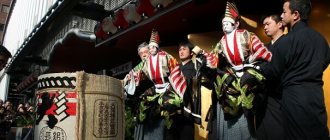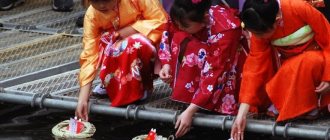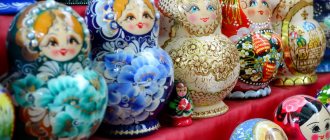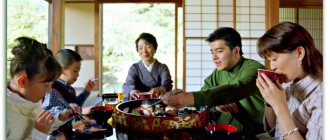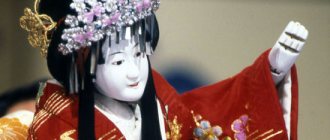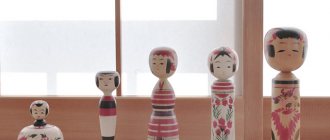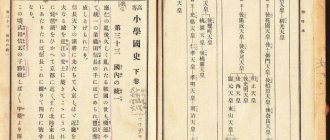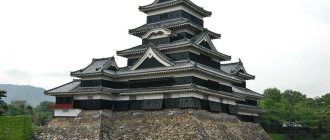In the beginning it was...
Despite the fact that throughout the world the nesting doll is considered an unchanging symbol of Russian culture, few people know that in fact the prototype of this famous folding doll was Daruma - the Japanese “matryoshka”, which was the personification of Bodhidharma. However, the history of its appearance has much more ancient roots.
The first folding dolls appeared in ancient China during the Song Empire, around 1000 AD. e. Outwardly, they did not look like dolls at all. These were small boxes, beautifully decorated and multifunctional. Much later, in the 18th century, the principle of their design began to be used to make sets of folding dolls: each larger doll contains a smaller doll. This is how the first “nesting dolls” appeared.
In the Chinese version, inside the smallest doll there was only one grain of rice - a symbol of divine spiritual food.
Fukuruma, dogu, kokeshi...
Dolls and toys are present in the everyday life of every nation. But only in Japan did they become an important part of not only everyday but also artistic culture.
The culture and traditions of the Land of the Rising Sun are very different from Russia, Europe, and even more so America. Although it is believed that the wooden fukurum toy of seven figures inserted into each other is the progenitor and ancient relative of our nesting doll.
Japanese dolls can be divided into two main groups: dolls for playing and dolls for admiring. There are also those that perform a decorative function, but once a year they become just a toy - on girls’ day, Hina Matsuri, and on Children’s Day (or boys’ day).
In ancient Japan, dolls were symbolic images of gods and people. The toy was used as an amulet, a talisman that attracted good deities and protected from evil spirits. According to the ancient Japanese religion of Shinto, the earth, trees, and plants are the habitats of deities-kami, therefore everything made from these materials is obviously endowed with magical protective powers.
The first dogu dolls appeared in Japan more than ten thousand years ago. Their distinctive feature is large eyes, like those of insects or owls. According to beliefs, they scare away evil spirits. Dogu were made in the form of animals or conventional human bodies. Such figurines were a kind of intermediary between the world of gods and the world of people. Dogu was used as an offering to the gods of the earth in exchange for wealth, prosperity and successful farming. It was believed that they could hold back formidable natural elements.
Usually dolls were made from simple and cheap materials - clay, wood, bamboo, straw, grass, old paper. Therefore, only the ingenuity and imagination of the master could create original and attractive toys. The production of toys was mainly carried out by simple artisans. Sometimes they themselves came up with intricate legends for the toys to make them more attractive.
All dolls have their own face and character, each has a story associated with it, sometimes heroic, sometimes humorous. The valiant Emperor Jimmu subdued his enemies with the light from the golden kite sitting at the end of his bow. A brave warrior from the Kuroda clan received a spear as a reward for his feat - he drank a huge bowl of sake to the bottom. The Japanese are very fond of images of the peach boy Momotaro, the young warrior Kintaro, who had amazing strength, and other heroes of legends and fairy tales.
The simplest mechanical dolls, karakuri, also became widespread. One of the most impressive models is the tyahakobi doll, or tea serving doll. She could approach a guest with a cup of tea and return back when the cup became empty.
Kokeshi dolls were made in memory of children who died from abortions or were killed in infancy. In ancient Japan, the birth of a girl was less desirable than a boy, which is why kokeshi are most often girls.
There was a curious tradition associated with dolls. Long ago, in poor villages, the appearance of a person able to go on pilgrimage was a once-in-a-lifetime event. Therefore, the villagers spent a very long time collecting a certain amount of money so that the pilgrim could go on a journey and bring a talisman from the famous temples for the entire village. This tradition continues today in the form of o-miyage - souvenirs that are brought to friends and family members from travel.
Many toys and dolls are associated with some legend or significant event or holiday. There are a lot of New Year's amulets in Japan. On New Year's Day, the Japanese make a wish, and if it does not come true within a year, the amulet must be burned as it did not live up to expectations.
Very often, the role of such an amulet is played by an eyeless daruma. It is believed that a spirit lives in it. You need to draw one eye on the doll and make a wish. If it is fulfilled by the end of the year, then the second eye is added to the daruma and left as a talisman. And if the wish does not come true, the doll is returned to the temple where it was bought. There they burn it so that all the bad things disappear with the smoke.
Despite the significant influences of Western culture, the traditions of Japanese folk toys have been preserved in their original form. The Japanese are very sensitive to this part of their culture and try to preserve ancient crafts.
The symbolism of ancient dolls and their magical qualities still exist today. Thus, the red color of the toy scares away evil spirits or attracts and destroys them. Monkeys and horses are symbols of fertility and wealth, dogs are symbols of the successful birth of children and their health. Some amulets protect against stress, fires, illnesses, earthquakes, while others give health, happiness, safety while traveling, good luck in business, a happy family life...
Interesting fact
With the advent of Buddhism, the tradition of cremation took hold.
Not only dead people, but also dolls belonging to them began to be cremated. It was believed that the doll contained the spirit of a person, and along with them his illnesses. Burning is a way to get rid of evil spirits. Dolls are real works of art that are passed down from generation to generation, very expensive because they are made by hand from expensive materials. Many craftsmen keep their manufacturing secrets secret. A set of dolls can be a significant part of a bride's dowry and become one of the most treasured family heirlooms.
Ekaterina Alekseyonok
What about in Japan?
According to legends, a long time ago a Buddhist monk originally from India settled in China and founded the Shaolin Monastery there, where he meditated day and night for 9 years. The sage's name was Bodhidharma. In Japanese, this name is known as Daruma. Like Saint Anthony, who was subjected to numerous temptations during his stay in the desert, Daruma had to overcome all kinds of trials that befell him every now and then. One day the sage realized that instead of meditating, he was in a dream. Then Daruma did a desperate act: cutting off his eyelids, throwing them to the ground and continuing his meditation. Subsequently, due to long sitting, Daruma lost control of his own arms and legs, so a wooden doll with his image, which appeared in Japan, is usually depicted as legless and armless.
Hundreds and thousands of Japanese annually perform a special New Year's ritual associated with their belief in the miraculous power of Daruma. The Japanese nesting doll itself has a round shape, in fact, being not so much a “matryoshka” in the traditional sense, but rather a tumbler doll. She has large round eyes without pupils, which is necessary to perform the ritual. They buy the doll in the temple and make a wish at home. Then one eye is painted, that is, Daruma's eye is opened. In this form, the matryoshka will stand in the house for a whole year and, if the wish is fulfilled during this time, then the second eye is painted with it. This is gratitude to Daruma. Otherwise, the Japanese nesting doll is taken back to the temple, burned and a new one is bought.
Japanese roots of the Russian nesting doll
Unexpected, right? After all, the nesting doll is without a doubt the embodiment of Russian culture! But how Russian is she really? Let's start with the fact that the nesting doll is quite young, it was born somewhere on the border of the 19th and 20th centuries. But despite this, the exact history of its origin is unknown. Basically, experts agree on the assumption that the nesting doll has Japanese roots. We will proceed from this and consider several legends of the Japanese origin of the nesting doll.
Legend No. 1 The prototype of the nesting doll was the Japanese doll Daruma , a traditional tumbler doll that personifies Bodhidharma, the god who brings happiness. According to Japanese legend, Daruma meditated tirelessly for nine years while looking at a wall. At the same time, Daruma was constantly exposed to various temptations, and one day he suddenly realized that instead of meditating, he fell into sleep. Then he cut off the eyelids from his eyes with a knife and threw them to the ground. Now, with his eyes constantly open, Bodhidharma could stay awake, and from his discarded eyelids a wonderful plant appeared that drove away sleep - this is how real tea grew. And later, from sitting for a long time, Daruma lost his arms and legs. This is why the wooden doll representing Daruma is depicted as legless and armless. She has large round eyes, but no pupils. The legend of the origin of the matryoshka doll from Daruma does not take into account the fact that this doll is not collapsible at all, but essentially a tumbler.
Legend No. 2 A fugitive Russian monk settled on the Japanese island of Honshu, who combined Eastern philosophy with a children's toy. As a basis, he took the figurine of one of the seven Japanese gods - Fukuruma (or Fukurokuju, or Fukurokuju. In fact, there are generally doubts about the existence of just such a pronunciation, since Japanese words are difficult to identify by ear). Fukurokuju is the god of wealth, happiness, abundance, wisdom and longevity. The pear-shaped shape of the old man’s figurine really resembles the shape of the classic Russian nesting doll. Fukurokuju is one of the so-called “seven gods of happiness”, shichifukuzin. Some adherents of the theory of “fatherhood” over the matryoshka doll of the elder Fukurokuju believe that the seven gods of happiness could be invested in each other, according to the principle of the modern matryoshka, and Fukurokuju was the main, largest detachable figurine.
Legend No. 3 The Japanese figurine was allegedly brought from the island of Honshu in 1890 to the Mamontovs’ estate in Abramtsevo near Moscow. The Japanese toy had a secret: his whole family was hiding in the old man Fukurumu. One Wednesday, when the artistic elite came to the estate, the hostess showed everyone a funny figurine. The detachable toy interested the artist Sergei Malyutin, and on its basis he created a sketch of a peasant girl in a headscarf and with a black rooster under her arm. The next young lady had a sickle in her hand. Another one with a loaf of bread. How could the sisters be without a brother - and he appeared in a painted shirt. A whole family, friendly and hardworking. However, this legend also has many blank spots. Firstly, the artist Malyutin’s legacy does not contain a sketch of the matryoshka doll. There is no evidence that Malyutin ever made this sketch. Moreover, turner V. Zvezdochkin (who is believed to have made the toy at Malyutin’s request) claimed that he came up with a new toy after seeing a suitable piece of wood in some magazine. Based on her model, he carved a figurine that had a “ridiculous appearance, resembled a nun” and was “deaf” (did not open), and gave the blank to a group of artists to paint.
And here is the very first Malyutin doll in full composition.
Legend No. 4 a wooden painted girl doll in Japan (kokeishi or kokeshi). A traditional wooden toy consisting of a cylindrical body and a head separately attached to it, turned on a lathe. Less commonly, the toy is made from a single piece of wood. A characteristic feature of kokeshi is the absence of arms and legs in the doll. Traditional kokeshi always depict girls only. Each doll is hand painted and has the artist's signature on the bottom. But the design of designer kokeshi is more diverse: shapes, sizes, proportions and colors can be almost any. In today's Japan, the popularity of kokeshi is so great that they have become one of the symbols of the vitality and attractiveness of the national culture, objects of aesthetic contemplation, as a cultural value of the distant past. Kokeshi is a popular souvenir these days.
*The publication uses materials from free access on the Internet.
Seven human bodies
There is another version of the origin of the Japanese nesting doll. The toy, according to her, was connected with Eastern philosophy by a Russian monk who fled to Japan. The prototype of this nesting doll was the image of Fukuruma (or Fukurokuju).
In Japanese tradition, there are seven gods of happiness - the so-called Shichifukujin, each of which controls only one of the seven human bodies. Among them there is one who is responsible for wisdom, high intellectual abilities and wealth - Fukuruma. The Japanese nesting doll with his image has its own unique features. This is, first of all, a high, elongated forehead, on which deep wrinkles are visible, and the staff that Fukuruma holds in his hands.
But how did the nesting doll itself appear? No one can say for sure. It is believed that once upon a time an unknown Japanese master created seven shichifukudzin dolls and placed one inside the other. The largest and most important among them was Fukuruma. His entire “divine” family was hiding in him.
Japanese god of luck
The prototype of the matryoshka had a beard. The ancient elder Fukuruma is a revered deity in Japan. The good sage is part of the pantheon of seven gods who are responsible for luck, happiness and prosperity. Fukuruma's appearance is specific: an oval body-head, slightly elongated at the top, decorated with a beard and small cunning eyes. Eight copies inside - eight human bodies. The ancient sages believed that each person has several “shells”.
Malyutin saw a cute figurine of Fukuruma, or, as he is called in Japan, Fukurokuja, at the end of the 19th century. However, there is another version about what really inspired the artist. Matryoshka Daruma is not such a pleasant parent.
Path to Russia
In continuation of this version of the appearance of the Russian nesting doll, it is worth noting that many seriously believe that this particular Japanese nesting doll, with the image of Fukuruma, was brought to Russia in 1890. And they brought him not just anywhere, but to the Abramtsev estate, where the typographer Anatoly Mamontov, brother of the famous Russian philanthropist Savva Mamontov, lived. He owned the “Children’s Education” workshop, where modernist artist Sergei Malyutin and turner Vasily Zvezdochkin worked.
When the artist saw a Japanese doll and was inspired by its unusual design, an interesting idea arose in his head. He soon outlined it to Zvezdochkin, from whom he ordered the production of the first Russian nesting doll in Russia. Malyutin painted the dolls with his own hands. At first they were modest girls in simple dresses, painted with gouache. However, later the painting began to become more complicated - nesting dolls with complex floral patterns and fairy-tale scenes appeared. The number of nesting dolls from one set also increased. But the very first nesting doll is still not lost. It is kept in the toy museum in Sergiev Posad.
LiveInternetLiveInternet
Traditional Japanese Kokeshi (木の偶人) are a wonderful example of the modest and elegant beauty of the East. Kokeshi ( kokeshi or kokeishi ) originated in Japan more than two hundred years ago, when local kijiya, woodcarvers who carved wooden bowls, trays and other utensils, used their craftsmanship to provide a souvenir for visitors to hot spring resorts for their children. a souvenir about the trip - a beautiful doll. Giving each other talismans is an ancient Japanese tradition.
Kokeshi is a wooden doll without arms or legs. The Japanese make such beauties from cherry, dogwood, birch or maple and decorate them with paintings. The craftsman grinds out a cylindrical body and head and connects them together. It is rare, but it happens that such Japanese dolls are made from one whole piece of wood. Next, he paints traditional Japanese floral and plant motifs using red, black, yellow or crimson colors. Tohoku, the northeastern agricultural region of the country, is considered to be the birthplace of the first kokeshi dolls. Some Japanese scholars say that such beauties appeared a thousand years ago, others believe that they were born in the middle of the Edo era (1630-1867).
Kokeshi dolls began to be passed down in families from generation to generation. If children played with such dolls, it was believed that this would definitely make a positive impression on the gods. Kokeshi inspired people; people believed that they would help harvest a good harvest and bring prosperity and good luck to the house.
Modern kokeshi are made according to the design of two schools: traditional and original. Kokeshi, according to old traditions, is made in Kyoto, Nara and Kagoshima. Despite their simplicity, these Japanese dolls vary in proportions, shapes and designs and thus reveal to connoisseurs the place where they were created. As you might guess, traditional dolls are simpler, but still have eleven types of shapes. For example, the head of the popular Naruko Kokeshi is able to turn, and then the baby makes a sound as if crying, which is why it was called the “crying doll.” Kokeshi of the traditional school are always handmade and depict girls.
The author's school appeared much later than the traditional one, so the creators of such kokeshi do not adhere to strict rules and make Japanese dolls of different shapes, sizes, colors and designs.
The style of making dolls in each region is always unique and inimitable. Secrets and skills were passed on from master to student, from father to son. Traditional dolls made today can be classified into eleven types: Tsuchiyu, Togatta, Yajiro, Naruko, Sakunami, Yamagata, Kijiyama, Nanbu ), Tsugaru, Zao-takayu and Hijioro.
There are several versions of the appearance of this souvenir toy.
The first version is mystical. It says that kokeshi originated from shamanic figurines for evoking the spirits that patronized the silk craft.
The second version is sad. To get rid of newborn children whose parents could not feed, kokeshi were placed in peasant houses as funeral dolls. This is where these Japanese dolls got their meaning as “the forgotten child.” Typically, the killed newborns were girls, who were valued much less in a poor peasant family than boys. This is why kokeshi always portray girls.
The third version is joyful. Once in the 17th century, the wife of the shogun (as the military ruler of the country was called in those days) came to Tohoku (remember, this is the birthplace of kokeshi), where there are many hot springs. She dreamed of a child, but could not conceive one. After visiting the healing waters, the woman became pregnant and gave birth to a wonderful girl. In tribute to this joyful event, Tohok masters created a doll, which later began to be made in different regions of the country.
Dolls, like flowers, are treated differently in Japan. And dolls are an integral part of Japanese culture. Japan is even called the “land of ten thousand dolls.” These are amulet dolls, talisman dolls, traditional dolls passed down from generation to generation - harmonious, sophisticated, made by skilled craftsmen.
Kokeshi are considered to be the embodiment of the eternal Japanese desire for default and inner beauty. They are given as a sign of friendship, sympathy, love or on the occasion of some pleasant event, as a talisman that brings good luck in business, prosperity in the home and harmony in the soul.
And kokeshi, like another Japanese daruma doll, lays claim to the title of the ancestor of the Russian rosy matryoshka doll.
This is a Japanese matryoshka fukuruma
Seven-seater nesting doll Fukurama, Japan, ca. 1890Seven-seater nesting doll "Fukurama", Japan, ca. 1890:
It is believed that the first Russian nesting doll was born in 1890 in the workshop of the Abramtsevo estate in new Moscow. The owner of the estate was Savva Mamontov, an industrialist and philanthropist.
One Saturday evening, someone brought a funny Japanese doll of a bald old man, Fukurama, into the workshop. The doll consisted of seven figures nested one inside the other. The origin of this doll is unknown for certain; no one knows where it came from. However, there are various legends, the most popular of which says that the first doll of this type was made by a Russian monk on the island of Honshu in Japan. In fact, this type of product, when several objects are inserted into one another, has been known for a very long time. Using this technology, Russian artisans produced wooden Easter eggs and apples for several centuries. However, the very idea of putting one product into another is quite ancient and goes back to the past of China, and which of the peoples inhabiting it is unknown, since it can be traced long before the unification of Chinese peoples.
Malyutin, the master of the Abramtsevo estate, painted the dolls in accordance with his own design. The first Russian nesting doll consisted of eight dolls and described a peasant family - a mother and 7 daughters. This set and some other sets are now kept in the Sergiev Posad Toy Museum.
Let's go back to Japan
We have already looked at three versions of the origin of the nesting doll, but there is a fourth. There is another Japanese nesting doll - kokeshi (or kokeshi). Its place of origin is considered to be Tohoku, the outskirts of the Japanese island of Honshu. As for the date of birth... Presumably, this is the 17th–18th centuries, but some experts claim that the doll was born more than 1000 years ago.
Kokeshi is a beautifully painted girl. It is made of wood, and it consists of two separate parts: a small cylindrical body and a head (see photo of a Japanese nesting doll below). It happens that kokeshi are made from a single block of wood, but this is very rare. Please note that this Japanese doll also has no arms or legs.
A variety of trees are suitable for making kokeshi - from maple and birch to the sophisticated cherry tree. The doll is usually painted in red, black and yellow and decorated with plant motifs that are so characteristic of Japanese culture.
Interestingly, traditional kokeshi has at least 11 types of shape. The most popular is “naruko kokeshi”. Her head can turn, and the doll itself makes a sound very similar to a quiet cry. Hence its second name – “crying kokeshi”.
Today there is a wide variety of designer kokeshi. Shapes, body proportions, colors can be absolutely any. Everything is at the discretion of the master. Pictures of Japanese nesting dolls with original designs are presented below.
Overall, kokeshi is an extremely popular toy in modern Japan. They symbolize cheerfulness, the stability of the way of Japanese culture, and the continuity of the traditions of their ancestors. They have significant cultural value. Perhaps, according to these characteristics, Japanese nesting dolls are very similar to their Russian “sisters”.
These are the assumptions about the origin of the Russian nesting doll. As it turned out, it is not as traditional for Russian culture as many are accustomed to think. One thing is certain: the prototype of collapsible dolls appeared in ancient times thanks to the efforts and imagination of Japanese craftsmen. What came of it? See for yourself.
Login to the site
Who doesn’t know the phrase “Russian nesting doll”? The intricate toy has become so popular in Russia that few can doubt its ancient origin and truly Russian nature. However, our nesting doll is just over a hundred years old. As a folk craft, the nesting doll is young, but its origin is shrouded in mystery...
History of Matryoshka
Many researchers adhere to the version of the origin of the nesting doll from a Japanese folding toy that depicted one of the seven Japanese gods of luck - Fukuruma (Fukurokuju, Fukurokuju) - the god of learning and wisdom. But the problem is that the Japanese do not have such a toy, as well as the word “fukurumu” itself.
Fukuroju
There is a legend from the 15th century, according to which seven Chinese sages moved to Japan on a treasure ship. Among them was the sage Fukuroju (Fukurokuju). In Japan, he is considered the god of wisdom, academic career, intuition and longevity. Fukuroju is a synthesized image of the three Chinese star elders Fuk, Luk and Sau (Fu, Lu and Shou), therefore it has another name Shou - Xing.
The image of Fukuroju, most often painted or sculpted (netsuke), was distinguished by his head stretched upward, which testified to his wisdom. A folding toy of this god, especially a popular one, most likely simply did not exist. In any case, it is very difficult to find material on the Japanese folding doll.
Some Russian and Japanese researchers consider the very popular Daruma doll in Japan to be the prototype of the matryoshka doll. The appearance of daruma figurines dates back to the 12th-14th centuries. This doll has a pronounced religious, cult and even magical meaning. Its peculiarity is the presence of empty eye sockets.
Daruma
When buying such a doll before the New Year and making a wish, the Japanese draw one eye on it and leave it for a year. If the wish comes true, a second eye is painted on her; if it doesn’t come true, she is taken back to the temple where she was bought. The dolls collected in this way are subsequently burned, but this ritual is not revenge on the doll, but a symbol of the search for new ways to implement the plan.
The Daruma doll acquired its familiar form approximately 200 years ago. It is often performed in the form of a tumbler doll, painted red to scare away smallpox demons, yellow, green and white. By the way, it is also considered the prototype of the Russian tumbler, which appeared in Russia at the beginning of the 19th century. Perhaps Daruma inspired Russian craftsmen to create the tumbler doll, but the nesting dolls... It’s very doubtful.
Traditional and very popular in Japan is the Kokeshi doll, which could also be the prototype of our matryoshka doll.
Kokeshi
If a Japanese family had a stillborn daughter or died before the age of three, a Kokeshi doll was made in memory of her. Therefore, the doll depicts only girls and has a cylindrical base with a moving round head. Kokeshi acquired the status of a kind of souvenir approximately 200 years ago.
What brings Kokeshi closer to the matryoshka doll?
Both Kokeshi and matryoshka dolls are made of wood and decorated with paintings. But the design and internal contents of the dolls are different. Therefore, it is unlikely that Kokeshi has anything to do with the nesting doll.
There is one more point to pay attention to. For almost the entire Edo period* (1603 - 1868), Japan pursued a sakoku policy, that is, the country did not trade or communicate with other countries except China and Holland, with which relations, presumably, were also limited. It is unlikely that dolls of ritual significance, like Darumu or Kokeshi, were exported in large quantities at this time.
Dolls play an important role in Japanese culture. Japanese craftsmen have created wonderful examples of dolls made of paper, fabric, clay, wood and other materials. Three-dimensional Japanese toys have existed for more than 1,500 years, but the doll in the form of a matryoshka appeared only at the end of the 19th century. At the end of the 19th century, the Russian matryoshka was born.
If there was a Japanese doll that served as the prototype for the matryoshka doll, why is it missing from traditional Japanese doll exhibitions?
The first matryoshka
It is believed that the first nesting doll was carved by the Russian turner V.P. Zvezdochkin, and painted with gouache by the artist Sergei Malyutin. And although the artist’s authorship is questioned in some sources due to the lack of preliminary sketches, he could have painted the toy impromptu.
The first Russian nesting doll, “Girl with a Rooster,” (art. Malyutin S.V.), consisted of eight figures.
Nesting products, including eggs, began to be produced at the Hakone resort in Japan around the middle of the 19th century (1844). But in Russian culture the principle of investment has been used for a long time. Russian craftsmen sharpened nested Easter eggs, apples, balls, and buckets.
In 1664, Prokopiy Ivanov was given the order to paint 170 Easter eggs. In the 18th-19th centuries, painting Easter eggs became widespread. In 1874, the Tyulin brothers, icon painters from Mstera, made Easter eggs to greet high-ranking persons. Each egg was carved from wood and consisted of two halves. The egg was elegant and light.
It must be said that wooden toys in Rus' were always made with great love. According to archaeological data, the existence of toys is known already in the 9th century.
In 1721, various toys were purchased for the children of Peter I, including three wooden children and a whole town with soldiers. We learn all this from the records of palace expenses.
The variety of toys and the creative imagination of their authors is amazing. In Russia there were a variety of wooden dolls: ladies, hussars, children, parsleys, clowns, soldiers, etc., not to mention images of animals. Handicraft toy production reached its greatest prosperity in the middle of the 19th century.
One can only be surprised by the abundance of not only wooden, but also other toys: “babies”, “blinkers”, “sailors”, “coaches”, “diapers”, “skeletons”, “waists”.
Moreover, many of them were mechanical. What kind of mechanisms were used to bring the toy to life? In addition, at the turn of the 19th – 20th centuries, a broad social movement developed for the preservation of national culture, which began to gradually lose its position under the onslaught of factory products. New forms of traditional products were sought.
But let's return to the nesting doll. If we compare the historical versions of the origin of tumblers and nesting dolls, we get the following picture. At the beginning of the 19th century, the Daruma doll was brought to Russia and, on its basis, Russian craftsmen composed Vanka - a stand-up.
At the end of the 19th century, the Fukuruma doll was brought in and Russian craftsmen finally figured out that instead of a folding wooden egg or apple, they could make a wooden folding doll. The question arises. Having a long and rich experience in making chiseled, carved, intricate mechanical wooden toys, the Russian man could not reach the matryoshka doll with his own mind?
Let me note that neither the idea of nesting, nor the idea of making dolls from wood, nor the shape of the nesting doll, which overall resembles an egg, were new to him. In addition, there is no direct evidence that these dolls were borrowed from Japanese models.
The fact that the nesting doll spread very quickly in different regions of Russia suggests that the soil for its emergence was simply well prepared by that time, nothing needed to be developed?!
The matryoshka is considered a symbol of Russian traditional culture. It contains a certain mystery, which foreigners call “the mystery of the Russian soul.” Isn’t this a confirmation of the truly Russian spiritual basis for the emergence of the Russian Matryoshka?
link
Modern dolls
Today, sets of collapsible dolls are very popular all over the world. In addition to traditional motifs, more and more often craftsmen are using their extraordinary and sometimes very bold ideas for painting nesting dolls. This is how nesting dolls appeared, depicting political leaders, musical idols, and animals. In fact, they show everything that the master’s imagination is capable of. The variety is so great that traditional motifs have almost completely faded into the background. Perhaps this is the secret of her popularity? With a huge selection to choose from, everyone can find something to their liking.
Japanese language and Japan
The name of the deity Fukurokuju is written using three characters.
Three goals are synthesized in his name. “Fuku” (Chinese: 福, pinyin: fú, pal: fu) means “happiness”, “roku” (Chinese: 禄, pinyin: lù, pal: lu) means “office well-being”, and “ju” (Chinese trad. 壽, ex. 寿, pinyin: shòu, pal.: show) - “longevity” and, if possible, immortality.
▂▃▅▇█▓▒░۩۞۩ ۩۞۩░▒▓█▇▅▃▂
Story
The origin of this deity has Chinese roots and is associated with the reign of the Chinese Emperor Wu (464 - 549).
At times, like another god of happiness, Jurojin, he is depicted as a typical Taoist saint Shou-shin, which creates confusion in their identification. Fukurokuju is considered the lord god of the southern Pole Star.
He lives in his own palace, surrounded by a fragrant garden. In this garden, among other things, the grass of immortality grows.
▂▃▅▇█▓▒░۩۞۩ ۩۞۩░▒▓█▇▅▃▂
Image
In Japanese iconographic tradition, Fukurokuju is depicted as an old man with a grotesquely elongated head. He is often accompanied by a crane (symbol of longevity) and a turtle (symbol of wisdom).
Sometimes Fukurokuju holds a tokkuri in his hands - a vessel for drinks, in particular for sake. Fukurokuju appreciates the art of contemplation, although he is not averse to humor and does not take offense at banter.
Fukurokuju resembles Jurojin, another of the seven Japanese gods of happiness, but differs from the latter in his elongated head. It is sometimes believed that the deities Fukurokuju and Jurojin are incarnated in the same body of a wise old man.
In addition to the usual staff, Fukurokuju is sometimes depicted with a fan in his hands. This implies the consonance of the words “fan” and “good” in Chinese. This fan can be used by God both to expel evil forces and sometimes to resurrect the dead.
According to legend, Fukurokuju, having lived a long life and reached old age, suddenly turned into a turtle. In this connection, figurines of Fukurokuju are widespread, demonstrating both his human and animal appearance.
For example, in many specialized stores, Fukurokuju “netsuke shifters” are very popular. And when looking directly (from the front) at such a netsuke standing on two legs, the human appearance of Fukurokuju appears before the eye. But if the netsuke is placed on the stomach, the turtle form of Fukurokuju is revealed.
▂▃▅▇█▓▒░۩۞۩ ۩۞۩░▒▓█▇▅▃▂
Tradition
In Japan, there is a tradition of placing an engraving of takarabune or a small boat carved from wood or bone under the pillow on New Year's Eve.
A dream on New Year's Eve is considered prophetic. Seeing Mount Fuji, eagles or eggplants in your dreams is a good omen. If you dream about something bad, you should throw a piece of paper with a picture of takarabune into the river in the morning. Its waters will carry all troubles far to the sea.
▂▃▅▇█▓▒░۩۞۩ ۩۞۩░▒▓█▇▅▃▂
Popularity
The figurine is popular and, in addition to becoming the prototype of the “matryoshka”, has been sold in the form of several products, including a board game. This is a set of discs painted in different colors, stacked. On top is a larger cylinder painted as Fukurokoju. Players take turns knocking out the discs, trying not to “drop” the sage.
▂▃▅▇█▓▒░۩۞۩ ۩۞۩░▒▓█▇▅▃▂
Japanese matryoshka
Like every national symbol, the nesting doll has a legend of its appearance. And as in many legends, the truth is overgrown with speculation.
It turns out that the Russian nesting doll is quite young, it was born somewhere on the border of the 19th and 20th centuries. The legend names the place of its appearance, the names of the turner and the artist who first turned and painted the doll. But with the rest of the details, not everything is clear and precise.
Almost all sources say that the prototype of the first matryoshka was a Japanese god. Indeed, in the 2nd half of the 19th century. In Europe and Russia, a fashion for everything Japanese appeared; there was an extraordinary demand for Japanese prints of any content and quality, exotic Asian figurines, etc. But there is no clarity with the specific prototype - the “father” of the nesting doll. The name most often heard is “Elder Fukuruma”.
The first group of legends “recognizes” in Fukuruma the long-headed Fukurokuju (福禄寿) - the god of wealth, happiness, abundance, wisdom and longevity. Fukurokuju is depicted as an old man with an unusually elongated forehead, often bearing signs of a phallic cult. The pear-shaped shape of the old man’s figurine really resembles the shape of the classic Russian nesting doll.
Some adherents of the theory of “fatherhood” over the matryoshka doll of the elder Fukurokuju believe that the seven gods of happiness could be invested in each other, according to the principle of the modern matryoshka, and Fukurokuju was the main, largest detachable figurine.
According to another version, only the form was borrowed from Fukurokuju, and the turner Vasily Zvezdochkin filled it with recursive content on Russian soil. Indeed, turned dishes and wooden detachable souvenirs, like Easter eggs, were, to put it mildly, not a novelty for Russian craftsmen, i.e., in technical terms, the nesting doll did not represent any particular novelty or complexity.
The second group of legends sees the relationship between the nesting doll and the founder of Zen Buddhism, Daruma Daruma (達磨) - the Japanese version of the name Bodhidharma, the name of the Indian sage who came to China and founded the Shaolin Monastery. The “invention” of Chan Buddhism (or Zen in Japanese) was preceded by a long period of meditation. Daruma sat for nine years staring at the wall. According to legend, due to sitting for a long time, Bodhidharma’s legs became paralyzed. That is why most often the daruma is depicted as legless.
Interestingly, in addition to the nesting doll and Zen Buddhism, Daruma is credited with another useful contribution. While meditating at his wall, Daruma was repeatedly exposed to various temptations and one day he suddenly realized that instead of meditating, he had plunged into the dreams of sleep. Then he cut off the eyelids from his eyes with a knife and threw them to the ground.
Now, with his eyes constantly open, Bodhidharma could stay awake, and from his discarded eyelids a wonderful plant appeared that drives away sleep - this is how tea grew. And non-Asian round eyes without eyelids became the second distinctive feature of Daruma’s images.
In Japan, Daruma tumbler figurines are used in New Year's ceremonies. A painted figurine of Daruma without painted pupils is bought at the temple and brought home. A wish is made in front of Daruma and one pupil is drawn. Apparently, Daruma wants to get a second pupil so much that he will make every effort to make his wish come true. If the wish comes true, Daruma receives a second eye, but if not, he is taken to the temple and burned.
▂▃▅▇█▓▒░۩۞۩ ۩۞۩░▒▓█▇▅▃▂
Material taken:
1) https://ru.wikipedia.org/wiki/%D0%A4%D1%83%D0%BA%D1%83%D1%80%D0%BE%D0%BA%D1%83%D0%B4 %D0%B7%D1%8E
2) https://utahch.blogspot.com/2011/10/blog-post_3187.html
3) https://actravel.ru/japan_matryoshka.html
4) https://eso.prundit.ru/fs/fukurokuju/
